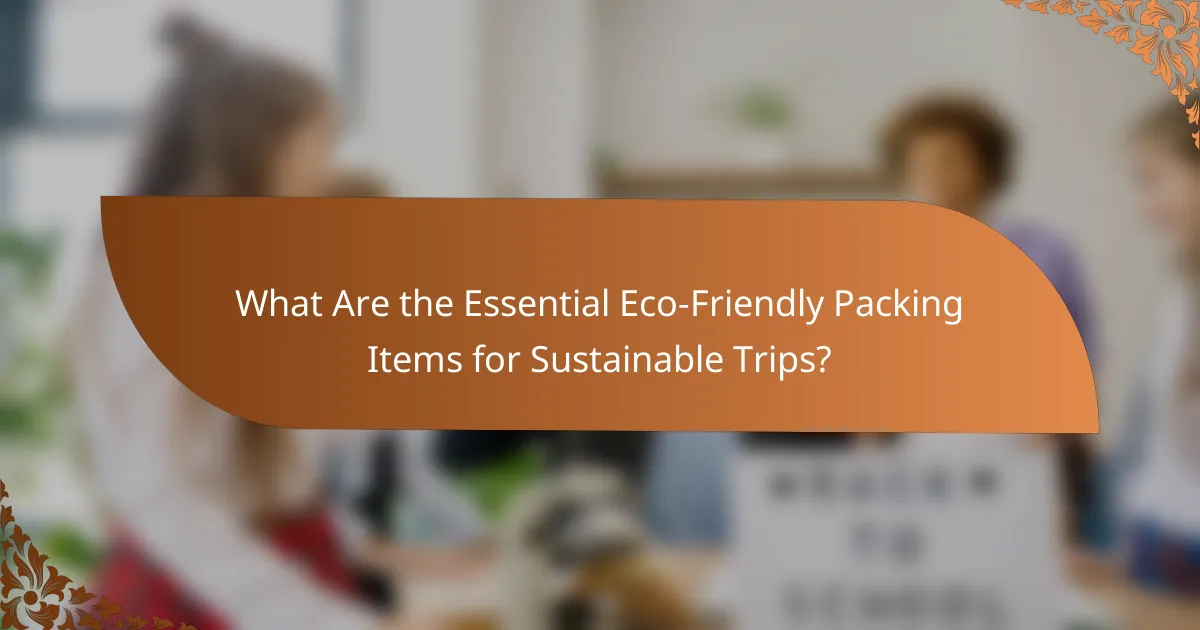Traveling sustainably is easier than ever with the right eco-friendly packing list. Essential items like reusable water bottles, biodegradable toiletries, and cloth shopping bags not only help reduce waste but also enhance your travel experience. By making conscious choices and selecting sustainable products, you can minimize your environmental impact while exploring new destinations.

What Are the Essential Eco-Friendly Packing Items for Sustainable Trips?
Essential eco-friendly packing items for sustainable trips include reusable water bottles, biodegradable toiletries, cloth shopping bags, eco-friendly travel utensils, and solar chargers. These items help reduce waste and minimize environmental impact while traveling.
Reusable water bottles
Reusable water bottles are crucial for staying hydrated without contributing to plastic waste. Look for stainless steel or BPA-free plastic options that keep drinks cold or hot for extended periods. Aim for a bottle with a capacity of around 500ml to 1 liter to ensure you have enough water during your travels.
When choosing a reusable bottle, consider features like a wide mouth for easy filling and cleaning, and a leak-proof design. Many brands offer collapsible options, which are great for saving space in your bag.
Biodegradable toiletries
Biodegradable toiletries, such as soap bars, shampoo bars, and bamboo toothbrushes, break down naturally and reduce plastic waste in landfills. Opt for products that are packaged in compostable materials or have minimal packaging to further decrease your environmental footprint.
Check for certifications like USDA Organic or cruelty-free labels to ensure the products align with your eco-friendly values. It’s also wise to consider solid toiletries, as they often last longer and are easier to pack.
Cloth shopping bags
Cloth shopping bags are a sustainable alternative to single-use plastic bags. They are durable, reusable, and can hold more weight, making them ideal for grocery shopping or carrying other items. Look for bags made from organic cotton or recycled materials.
Keep a couple of foldable cloth bags in your luggage for convenience. Some bags even come with pockets or compartments, which can help keep your items organized while you shop.
Eco-friendly travel utensils
Eco-friendly travel utensils, such as bamboo or stainless steel cutlery, help eliminate the need for disposable plastic utensils. These utensils are lightweight, durable, and easy to clean, making them perfect for meals on the go.
Consider a travel set that includes a fork, knife, spoon, and chopsticks, often packaged in a compact case. This not only reduces waste but also encourages you to eat more sustainably while traveling.
Solar chargers
Solar chargers harness sunlight to power your devices, making them an excellent eco-friendly option for charging electronics while traveling. Look for portable solar chargers with multiple USB ports to charge several devices simultaneously.
When selecting a solar charger, consider its efficiency and charging speed. Aim for a model that can fully charge a smartphone in a few hours under direct sunlight. This way, you can stay connected without relying on conventional energy sources.

How Can I Minimize Waste While Traveling?
Minimizing waste while traveling involves making conscious choices that reduce environmental impact. By selecting sustainable products, using reusable containers, and opting for digital resources, you can significantly lower your waste footprint during trips.
Choose zero-waste products
Zero-waste products are designed to eliminate waste throughout their lifecycle. Look for items such as bamboo toothbrushes, stainless steel straws, and biodegradable soap. These alternatives not only reduce plastic use but also often come with less packaging.
When shopping for zero-waste items, consider local brands that prioritize sustainability. This not only supports the local economy but also reduces the carbon footprint associated with shipping products long distances.
Pack in reusable containers
Using reusable containers for food and toiletries can drastically cut down on single-use plastics. Invest in durable, lightweight options like glass or stainless steel containers for meals and snacks. For toiletries, consider silicone travel bottles to avoid disposable packaging.
Additionally, packing a foldable reusable bag can be handy for shopping or carrying extra items during your travels. This simple step helps you avoid plastic bags and supports a more sustainable lifestyle.
Opt for digital tickets and itineraries
Digital tickets and itineraries reduce paper waste and are often more convenient. Many airlines, train services, and attractions now offer mobile ticketing options that can be stored on your smartphone. This eliminates the need for printed documents and helps keep your travel organized.
When planning your trip, use apps to manage your itinerary and bookings. This not only minimizes waste but also allows for easy updates and changes without the hassle of paper. Always check if a venue offers a digital option before printing any tickets.

What Are the Best Practices for Sustainable Travel?
The best practices for sustainable travel focus on minimizing environmental impact while maximizing local benefits. This includes supporting local economies, using eco-friendly transportation options, and taking steps to offset your carbon footprint.
Support local businesses
Supporting local businesses is a key practice for sustainable travel. This means choosing locally-owned hotels, restaurants, and shops over international chains. Not only does this help the local economy, but it also provides a more authentic travel experience.
Consider dining at family-run eateries or purchasing handmade goods from local artisans. This not only fosters community growth but also reduces the carbon footprint associated with transporting goods over long distances.
Use public transportation
Using public transportation is an effective way to reduce your travel emissions. Buses, trains, and trams often have a lower environmental impact compared to individual car travel. In many cities, public transport is not only more sustainable but also more economical.
When planning your trip, research local transit options and consider purchasing multi-day passes for convenience. This can save you money while encouraging you to explore areas you might not visit otherwise.
Offset carbon emissions
Offsetting carbon emissions involves compensating for the greenhouse gases produced during your travels. This can be achieved through various programs that invest in renewable energy, reforestation, or energy efficiency projects. Many airlines and travel companies now offer carbon offset options at the time of booking.
Before traveling, calculate your expected emissions using online calculators and choose an offset program that aligns with your values. This proactive approach can significantly mitigate the environmental impact of your trip.

What Should I Consider When Choosing Eco-Friendly Travel Gear?
When selecting eco-friendly travel gear, prioritize materials, durability, and the brand’s environmental policies. These factors ensure that your gear not only minimizes environmental impact but also lasts for multiple trips, reducing waste.
Material sustainability
Material sustainability refers to the environmental impact of the materials used in travel gear. Look for products made from recycled, organic, or biodegradable materials, as these options often have a lower carbon footprint. For example, bags made from recycled plastics or organic cotton are preferable to those made from conventional synthetics.
Additionally, consider certifications such as Global Organic Textile Standard (GOTS) or OEKO-TEX, which indicate that materials meet specific environmental and safety standards. This can help you make informed choices about the sustainability of your gear.
Durability and longevity
Durability and longevity are crucial for eco-friendly travel gear, as longer-lasting products reduce the need for replacements and minimize waste. Look for items that are well-constructed and made from robust materials that can withstand wear and tear. For instance, high-quality backpacks with reinforced stitching and weather-resistant fabrics can last for years.
When evaluating durability, consider warranties or guarantees offered by manufacturers. A good warranty often reflects the brand’s confidence in the longevity of their products, making it a practical factor in your decision-making process.
Brand environmental policies
Understanding a brand’s environmental policies is essential when choosing eco-friendly travel gear. Research companies that prioritize sustainability in their operations, such as those that use renewable energy, minimize waste, or engage in fair trade practices. Brands that are transparent about their supply chain and environmental impact are often more trustworthy.
Look for certifications or memberships in organizations that promote sustainable practices, such as the Sustainable Apparel Coalition or Fair Trade. These affiliations can provide assurance that the brand is committed to reducing its ecological footprint and promoting ethical manufacturing processes.

How Can I Create a Sustainable Packing List for Different Destinations?
To create a sustainable packing list tailored to various destinations, consider the local climate, activities, and available resources. This approach ensures you pack only what you need while minimizing waste and environmental impact.
Consider climate and activities
Understanding the climate and planned activities at your destination is crucial for effective packing. For instance, if you’re heading to a tropical region, lightweight, breathable clothing is essential, while colder destinations require warmer layers. Research the average temperatures and weather patterns to make informed choices.
Additionally, consider the activities you plan to engage in, as they dictate specific gear. For hiking, durable footwear and moisture-wicking fabrics are important, whereas a beach trip may require swimwear and sun protection. Tailoring your packing list to these factors can reduce unnecessary items and promote sustainability.
As a practical tip, create a checklist based on your destination’s climate and activities. This can help you avoid overpacking and ensure you bring only the essentials, contributing to a more eco-friendly travel experience.
